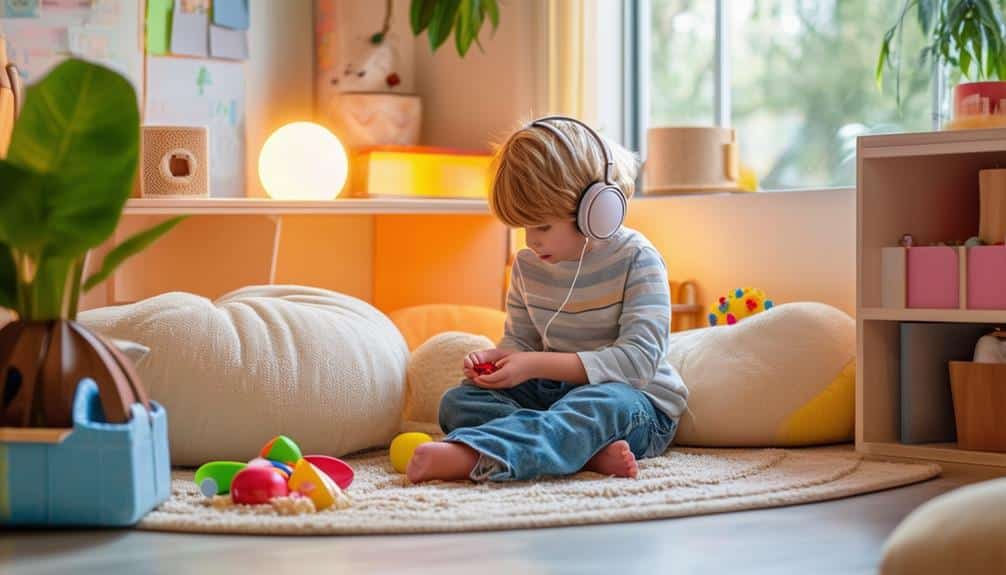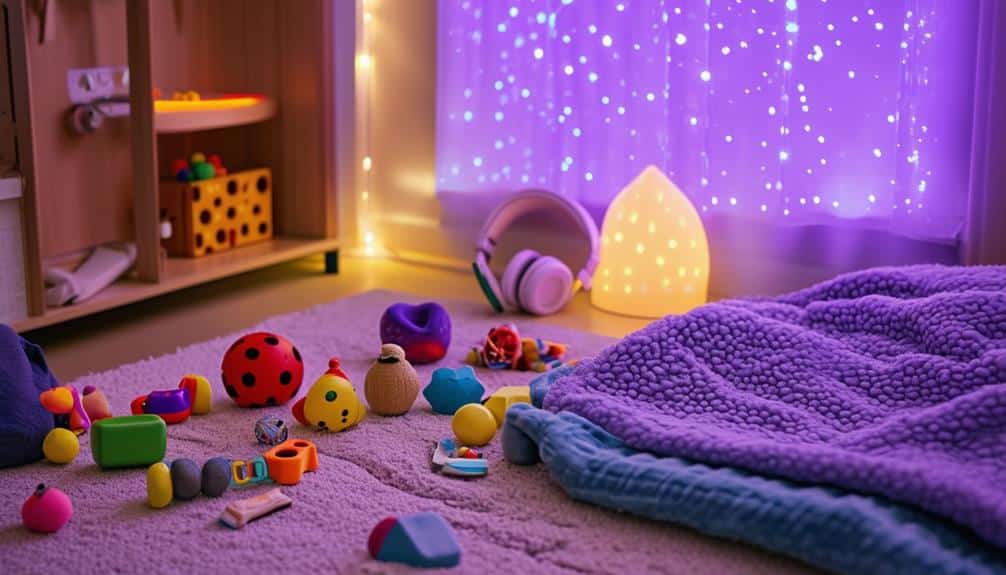Spotting sensory issues early in children is essential for their development. Begin by observing behavioral patterns like hand-flapping or extreme reactions to stimuli. Sensory checklists can provide a thorough assessment to identify specific challenges. Implement regular sensory breaks to prevent overload and create calm spaces to aid self-regulation. Offering alternative seating and using sensory tools such as weighted blankets or fidget toys can also be beneficial. Finally, collaborating with specialists, including occupational and speech therapists, guarantees tailored interventions. By focusing on these strategies, you can more effectively support a child’s sensory needs and encourage their growth. Discover the total approach ahead.
Key Takeaways
- Observe for hand-flapping, toe-walking, or extreme reactions to sensory stimuli.
- Monitor responses to sensory input to identify potential triggers.
- Use sensory checklists for a comprehensive assessment of sensory processing issues.
- Provide regular sensory breaks and calm spaces for self-regulation.
- Collaborate with specialists for personalized evaluations and evidence-based interventions.
Spot Sensory Issues: Observe Behavioral Patterns
Observing a child’s behavioral patterns can provide critical insights into potential sensory issues. Children may exhibit repetitive behaviors such as hand-flapping or toe-walking, which can indicate sensory processing challenges. Noticing these patterns is essential for caregivers and educators who aim to support developmental needs effectively.
Extreme reactions to sensory stimuli—such as sounds, lights, textures, or smells—can also signal sensory issues. These reactions often appear disproportionate to the actual sensory input, suggesting over-reactivity. Conversely, some children may display under-reactivity, seemingly indifferent to sensory experiences that typically attract attention.
Challenges with changes in routine and adjustments are common among children with sensory issues. Unexpected sensory input can exacerbate these difficulties, causing distress and impacting behavior. Monitoring how a child responds to different sensory experiences across various environments can reveal essential patterns and triggers.
Use Sensory Checklists
Sensory checklists can be essential in identifying and understanding a child’s sensory processing issues, allowing for early and effective intervention. These checklists, consisting of targeted questions, offer insight into a child’s responses to sensory inputs such as touch, sound, taste, and movement. Caregivers and professionals can better understand the child’s distinct sensory profile by systematically evaluating these sensory behaviors.
Using sensory checklists provides several pivotal benefits:
- Early Detection: Identifying sensory processing issues early allows for timely intervention, which can improve children’s developmental outcomes and quality of life.
- Comprehensive Assessment: Sensory checklists cover a broad range of sensory areas, ensuring no aspect of a child’s sensory experience is overlooked.
- Informed Interventions: Understanding specific sensory responses helps tailor more effective interventions that support the child’s needs.
Professionals and caregivers can utilize these checklists to observe patterns, pinpoint challenges, and develop targeted strategies. Embracing sensory checklists in early developmental stages not only aids in accurate evaluation but also fosters a more empathetic and informed approach to addressing sensory processing issues, ultimately supporting children in thriving environments.
Implement Sensory Breaks

Implementing sensory breaks effectively begins with identifying activities that trigger sensory overload and designating calm spaces where people can retreat to regulate their sensory input. By scheduling these breaks at regular intervals, we can provide consistent opportunities for sensory management, reducing the likelihood of meltdowns and improving overall behavior. This evidence-based approach supports developmental growth by fostering an environment conducive to focus and mental stability.
Identify Triggering Activities
To effectively identify triggering activities, it’s essential to closely monitor behavior changes during specific tasks or within particular environments. Observing behavior changes can provide crucial clues about what activities cause sensory overload and when sensory breaks are necessary. This allows for timely intervention, aiding in self-regulation and overall well-being.
Implementing sensory breaks is essential for preventing sensory overload. These breaks offer an opportunity to engage in sensory-friendly activities, such as swinging or deep pressure tasks, allowing individuals to recalibrate their sensory systems. Tailoring these breaks to personal sensory needs can make them more effective.
It is essential to track behavior changes and mood fluctuations to guarantee the success of sensory breaks. By doing so, caregivers and educators can adjust the activities to meet the person’s needs better. Here are three key steps to help in this process:
- Observe and Record: Keep a detailed log of behavior changes during specific tasks and environments.
- Analyze Patterns: Identify common triggers and determine the most effective sensory-friendly activities.
- Adjust Accordingly: Modify sensory breaks based on tracked data to support personal sensory needs better.
Designate Calm Spaces
Designating tranquil spaces within environments provides children with sensory issues a dedicated area to regulate and manage sensory input, fostering mental well-being and self-regulation. Sensory breaks in these calm spaces can be instrumental in preventing sensory overload and subsequent meltdowns. These designated areas are typically equipped with weighted blankets, noise-canceling headphones, and fidget toys, which offer tactile and auditory relief.
| Tool | Purpose |
|---|---|
| Weighted Blankets | Provide deep pressure stimulation, aiding in self-regulation and reducing anxiety. |
| Noise-Canceling Headphones | Block out overwhelming background noise, enhancing focus and reducing sensory overload. |
| Fidget Toys | Offer tactile stimulation, promoting concentration and well-being. |
Incorporating calm spaces within environments can enhance focus and reduce anxiety for children with sensory issues. Such areas promote self-regulation and contribute to the child’s well-being. By offering a sanctuary where children can take sensory breaks, caregivers and educators can more effectively support the child’s developmental needs. Providing these tools and spaces demonstrates a commitment to creating inclusive environments where every child can thrive and manage their sensory experiences with confidence and comfort.
Schedule Regular Intervals
Regularly scheduled sensory breaks are essential in helping children with sensory issues regulate their sensory input and maintain focus throughout the day. By incorporating regular intervals for these breaks, children can focus, mitigating the risk of sensory overload and enhancing their ability to engage in learning and other activities.
Implementing structured sensory breaks can be highly effective for promoting self-regulation. These breaks can include deep breathing exercises, stretching, or using sensory tools to provide specific sensory input. Establishing a significant routine for these breaks is vital for supporting a child’s sensory needs and ensuring consistency throughout their day.
Consider the following strategies for adequate sensory breaks:
- Frequent Intervals: Schedule sensory breaks throughout the day to prevent sensory overload and promote ongoing self-regulation.
- Variety of Activities: Incorporate sensory tools and activities, such as deep breathing exercises, to cater to different sensory systems and preferences.
- Predictable Routine: Maintain a consistent schedule for sensory breaks to create a predictable routine, helping children anticipate and prepare for these moments of regulation.
Provide Alternative Seating
Incorporating alternative seating options like stability balls, wobble cushions, and standing desks can greatly aid children with sensory issues in maintaining focus and regulation within the classroom. These flexible seating arrangements cater to students’ diverse sensory processing needs, allowing them to select options that align with their personal preferences and comfort levels.
For instance, stability balls and wobble cushions can help reduce fidgeting and enhance posture, subsequently improving attention span. Some learners may benefit from the vestibular input provided by rocking chairs, while others might find textured cushions offer the tactile stimulation they need to remain engaged. Research indicates that such sensory-friendly seating can positively impact behavior, concentration, and overall academic performance.
Utilize Sensory Tools

To further support children with sensory processing challenges, utilizing sensory tools can provide tailored input that aids in self-regulation and focus. Sensory tools offer various forms of tactile, auditory, and proprioceptive input, essential for children maneuvering sensory-rich environments. These tools enhance sensory processing skills and foster mood regulation and concentration.
Incorporating sensory tools into daily routines can be highly beneficial. Here are three effective strategies:
- Weighted Blankets: These provide deep pressure stimulation, which can have a calming effect on the nervous system, aid in self-regulation, and improve sleep quality.
- Chewable Jewelry: This offers a safe and discreet way for children to receive oral sensory input, which can help them stay focused and calm during activities.
- Noise-Canceling Headphones: These help manage auditory input in noisy environments, reducing sensory overload and enhancing the child’s ability to concentrate.
Additional sensory tools like sensory brushes and proprioceptive input devices further support children by providing the necessary stimulation to help them maneuver their environments more effectively. By integrating these tools, caregivers and educators can create supportive, sensory-rich environments that foster growth and development in children with sensory processing challenges.
Collaborate With Specialists
Engaging with specialists such as occupational therapists, speech therapists, and other professionals is essential for effectively addressing sensory processing challenges in children. These specialists possess the expertise to conduct thorough evaluations for accurately identifying specific sensory issues. By meticulously evaluating a child’s sensory processing abilities, specialists can pinpoint the exact nature of the challenges and devise targeted interventions.
Occupational therapists and speech therapists play pivotal roles in providing tailored therapy sessions that address sensory needs. Their interventions are evidence-based and designed to foster developmental progress. Through customized strategies, these professionals can create personalized sensory diets and treatment plans that cater to each child’s distinct needs. Such customized approaches ensure that the support provided is both relevant and practical.
Collaboration with specialists facilitates early identification of sensory processing difficulties and ensures ongoing, practical support. This collaborative effort empowers caregivers and educators to implement well-informed strategies that promote optimal development. Ultimately, working with these professionals helps to build a robust support system around the child, fostering an environment where sensory issues can be managed proactively and compassionately.
Frequently Asked Questions
How to Support a Child With Sensory Issues?
Supporting a child with sensory issues involves early identification, professional evaluation, and creating a sensory-friendly environment. Collaborate with educators and caregivers to guarantee a consistent, tailored approach that effectively addresses the child’s sensory needs.
What Are the Interventions for Sensory Issues?
Interventions for sensory issues are like tailor-made suits precisely fitted to each child’s needs. They include sensory integration therapy by occupational therapists, sensory gyms, tailored sensory diets, and parental involvement, all based on thorough evaluations.
What Are Coping Strategies for Sensory Sensitivity?
Coping strategies for sensory sensitivity include deep breathing exercises, creating sensory-friendly environments, using noise-canceling devices, engaging in grounding physical activities, and employing visual schedules. These approaches provide comfort and structure, aiding in regulating feelings and sensory management.
How Do You Calm Down a Child With Sensory Processing Disorder?
Calming a child with Sensory Processing Disorder involves creating a sensory-friendly environment, incorporating calming techniques like deep pressure and proprioceptive activities, and developing a sensory diet tailored to the child’s needs in collaboration with an occupational therapist.


Recent Comments